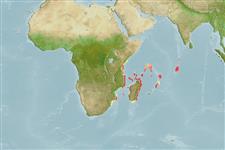Classification / Names
Nombres comunes | Sinónimos | Catalog of Fishes(Género, Especie) | ITIS | CoL | WoRMS | Cloffa
>
Ophidiiformes (Cusk eels) >
Bythitidae (Livebearing brotulas)
Etymology: Majungaichthys: Named for Majunga (Mahajanga) province of Madagascar, the type locality of the type species; agalegae: Named for its type locality, Agalega Islands; noun in apposition.
Eponymy: A toponym not an eponym; named after the Agaléga Islands, Mauritius, Indian Ocean. (Ref. 128868), visit book page.
More on authors: Schwarzhans & Møller.
Environment: milieu / climate zone / depth range / distribution range
Ecología
marino bentopelágico; rango de profundidad 4 - 5 m (Ref. 88966). Tropical
Western Indian Ocean: off northwestern Madagascar (Nosy Mitsio Archipelago) to the Agalega Islands (Mauritius).
Tamaño / Peso / Age
Maturity: Lm ? range ? - ? cm
Max length : 4.0 cm SL macho / no sexado; (Ref. 88966); 3.5 cm SL (female)
Short description
Claves de identificación | Morfología | Morfometría
Radios blandos dorsales (total) : 71 - 75; Radios blandos anales: 55 - 62; Vértebra: 42 - 44. This species is distinguished by the following characters: vertebrae 12 + 30-32 = 42-44, pleural ribs on vertebrae 2-11; rays on dorsal fin 71-75 and anal fin 55-62, D/A 20-21; distance from base of ventral fin to base of anal fin 25.5-28; head with rounded snout, scale patch on cheeks with 4 or 5 rows on upper cheek and 2 or 3 rows on lower cheek; p2 pairs of pseudoclaspers almost equally large, outer flap-shaped with broadened tip, inner narrower with anteriorly inclined tip; otolith with indistinctly divided sulcus with extremely small cauda, ostium length to cauda length about 7:1, sulcus slightly inclined, otolith length to otolith height 2.1, otolith length to sulcus length 1.8-1.9 (Ref. 88966).
Life cycle and mating behavior
Madurez | Reproducción | Puesta | Huevos | Fecundidad | Larva
Schwarzhans, W. and P.R. Møller, 2011. New Dinematichthyini (Teleostei: Bythitidae) from the Indo-west Pacific, with the description of a new genus and five new species. The Beagle, Records of the Museums and Art Galleries of the Northern Territory 27:161-177. (Ref. 88966)
IUCN Red List Status (Ref. 130435: Version 2024-1)
Threat to humans
Harmless
Human uses
Herramientas
Special reports
Download XML
Fuentes de Internet
Estimates based on models
Preferred temperature (Ref.
123201): 26 - 27.8, mean 27.3 °C (based on 134 cells).
Phylogenetic diversity index (Ref.
82804): PD
50 = 0.7500 [Uniqueness, from 0.5 = low to 2.0 = high].
Bayesian length-weight: a=0.00447 (0.00172 - 0.01163), b=3.10 (2.87 - 3.33), in cm total length, based on LWR estimates for this (Sub)family-body shape (Ref.
93245).
Nivel trófico (Ref.
69278): 3.2 ±0.5 se; based on size and trophs of closest relatives
Fishing Vulnerability (Ref.
59153): Low vulnerability (10 of 100).
